‘Liquid gold’ gives best start to the newborns


Better yet is seeing colostrum, or ‘liquid gold’, being suckled before we leave.
As a practice we are supporting the #ColostrumisGold Campaign, spearheaded by RUMA. Whilst the message is simple, and one we have heard before, it is as important as ever.
Advertisement
Hide AdAdvertisement
Hide AdIt comes as a timely reminder as the industry moves to reduce reliance on antibiotics.
We cannot stress the ‘liquid gold’ properties of colostrum enough. Lambs and calves that don’t receive enough become susceptible to numerous diseases. Studies show that lambs fed adequate quality colostrum at birth will not succumb to watery mouth, while cases of pneumonia in calves can be halved.
So what can we do to help?
Firstly, we need to make sure the colostrum is there in the first place. Nutrition planning for the pregnant dam is key. Keep a close eye on condition scores and address thin animals sooner rather than later, be that with extra feed or veterinary attention.
Blood sampling dams three to four weeks before lambing/calving is excellent to ensure adequate nutritional targets are being hit.
Advertisement
Hide AdAdvertisement
Hide AdSecondly, the colostrum needs to get into the lamb/calf quickly and in sufficient quantities – 50ml/kg ideally within two hours of birth. Plenty of shelter, reducing stocking density, and dagging sheep can facilitate this.
Colostrum can set a calf or lamb up for a much more productive and healthier life. Not only can we reduce the need for antibiotics within the first few days of life, but throughout the animal’s entire production, leading to reduced costs and improved profitability.